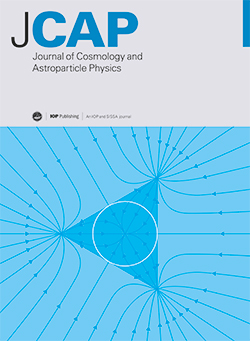在n体模拟中使用基于gpr的模拟器加速再电离时期的HI密度预测
IF 5.9
2区 物理与天体物理
Q1 ASTRONOMY & ASTROPHYSICS
Journal of Cosmology and Astroparticle Physics
Pub Date : 2025-06-19
DOI:10.1088/1475-7516/2025/06/045
引用次数: 0
摘要
建立快速和准确的方法来模拟再电离时期(EoR)中性氢的分布,对于解释即将到来的21厘米观测至关重要。再电离半数值模型的一个关键组成部分是坍缩分数场fcoll(x),它代表了每个位置暗物质晕内的质量分数。使用高动态范围n体模拟来获得这是计算上的禁止和半解析方法,虽然速度快,但最终会损害准确性。在这项工作中,我们通过开发一种机器学习模型来弥补这一差距,该模型可以通过从以暗物质密度对比δ为条件的fcoll的完整分布中采样来生成fcoll地图。模型的条件分布函数和输入密度场均取自低动态范围n体模拟,运行效率更高。我们通过将ML模型的预测与高动态范围n体模拟进行比较来评估其性能。利用这些fcoll图,我们通过再电离的半数值代码计算HI和HII图。我们能够在< 10%的水平上恢复大尺度高密度场功率谱(k > 1 h Mpc-1),而在所有尺度上都能以远低于10%的误差再现高密度场。与现有的半解析式处方相比,我们的方法在生成坍塌分数场方面具有显著提高的准确性,为再电离建模提供了一种鲁棒和有效的替代方法。本文章由计算机程序翻译,如有差异,请以英文原文为准。
Accelerating HI density predictions during the Epoch of Reionization using a GPR-based emulator on N-body simulations
Building fast and accurate ways to model the distribution of neutral hydrogen during the Epoch of Reionization (EoR) is essential for interpreting upcoming 21 cm observations. A key component of semi-numerical models of reionization is the collapse fraction field fcoll(x), which represents the fraction of mass within dark matter halos at each location. Using high-dynamic range N-body simulations to obtain this is computationally prohibitive and semi-analytical approaches, while being fast, end up compromising on accuracy. In this work, we bridge the gap by developing a machine learning model that can generate fcoll maps by sampling from the full distribution of fcoll conditioned on the dark matter density contrast δ. The conditional distribution functions and the input density field to the model are taken from low-dynamic range N-body simulations that are more efficient to run. We evaluate the performance of our ML model by comparing its predictions to a high-dynamic range N-body simulation. Using these fcoll maps, we compute the HI and HII maps through a semi-numerical code for reionization. We are able to recover the large-scale HI density field power spectra (k ≲ 1 h Mpc-1) at the ≲ 10% level, while the HII density field is reproduced with errors well below 10% across all scales. Compared to existing semi-analytical prescriptions, our approach offers significantly improved accuracy in generating the collapse fraction field, providing a robust and efficient alternative for modeling reionization.
求助全文
通过发布文献求助,成功后即可免费获取论文全文。
去求助
来源期刊

Journal of Cosmology and Astroparticle Physics
地学天文-天文与天体物理
CiteScore
10.20
自引率
23.40%
发文量
632
审稿时长
1 months
期刊介绍:
Journal of Cosmology and Astroparticle Physics (JCAP) encompasses theoretical, observational and experimental areas as well as computation and simulation. The journal covers the latest developments in the theory of all fundamental interactions and their cosmological implications (e.g. M-theory and cosmology, brane cosmology). JCAP''s coverage also includes topics such as formation, dynamics and clustering of galaxies, pre-galactic star formation, x-ray astronomy, radio astronomy, gravitational lensing, active galactic nuclei, intergalactic and interstellar matter.
 求助内容:
求助内容: 应助结果提醒方式:
应助结果提醒方式:


